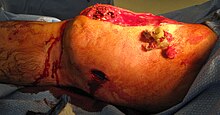
Back رضح نافذ Arabic Пранікальная рана Byelorussian Traumatisme penetrant Catalan Traumatismo penetrante Spanish ترومای نافذ Persian Trauma tajam ID Trauma tajam Malay Проникающее ранение Russian Penetrating trauma SIMPLE Үтәли җәрәхәт Tatar
| Penetrating trauma | |
|---|---|
 | |
| Acute penetrating trauma from a close-range shotgun blast injury to knee. Birdshot pellets are visible in the wound, within the shattered patella. The powder wad from the shotgun shell has been extracted from the wound, and is visible at the upper right of the image. | |
| Specialty | Trauma surgery, General surgery, emergency medicine |
Penetrating trauma is an open wound injury that occurs when an object pierces the skin and enters a tissue of the body, creating a deep but relatively narrow entry wound. In contrast, a blunt or non-penetrating trauma may have some deep damage, but the overlying skin is not necessarily broken and the wound is still closed to the outside environment. The penetrating object may remain in the tissues, come back out the path it entered, or pass through the full thickness of the tissues and exit from another area.[1]
A penetrating injury in which an object enters the body or a structure and passes all the way through an exit wound is called a perforating trauma, while the term penetrating trauma implies that the object does not perforate wholly through.[2] In gunshot wounds, perforating trauma is associated with an entrance wound and an often larger exit wound.
Penetrating trauma can be caused by a foreign object or by fragments of a broken bone. Usually occurring in violent crime or armed combat,[3] penetrating injuries are commonly caused by gunshots and stabbings.[4]
Penetrating trauma can be serious because it can damage internal organs and presents a risk of shock and infection. The severity of the injury varies widely depending on the body parts involved, the characteristics of the penetrating object, and the amount of energy transmitted to the tissues.[4] Assessment may involve X-rays or CT scans, and treatment may involve surgery, for example to repair damaged structures or to remove foreign objects. Following penetrating trauma, spinal motion restriction is associated with worse outcomes and therefore it should not be done routinely.[5]
- ^ Stewart MG (2005). "Principles of ballistics and penetrating trauma". In Stewart MG (ed.). Head, Face, and Neck Trauma: Comprehensive Management. Thieme. pp. 188–94. ISBN 3-13-140331-4. Retrieved 2008-06-12.
- ^ Cite error: The named reference
Blank06was invoked but never defined (see the help page). - ^ Enepekides DJ, Donald PJ (2005). "Frontal sinus trauma". In Stewart MG (ed.). Head, Face, and Neck Trauma: Comprehensive Management. Thieme. p. 26. ISBN 3-13-140331-4. Retrieved 2008-06-12.
- ^ a b Pollak AN, Gupton CL (2002). Emergency Care and Transportation of the Sick and Injured. Boston: Jones and Bartlett. p. 562. ISBN 0-7637-2046-1. Retrieved 2008-06-12.
Penetrating trauma.
- ^ Velopulos, CG; Shihab, HM; Lottenberg, L; Feinman, M; Raja, A; Salomone, J; Haut, ER (28 December 2017). "Prehospital Spine Immobilization/Spinal Motion Restriction in Penetrating Trauma: a Practice Management Guideline from the Eastern Association for the Surgery of Trauma (EAST)". The Journal of Trauma and Acute Care Surgery. 84 (5): 736–744. doi:10.1097/TA.0000000000001764. PMID 29283970. S2CID 23003890.
© MMXXIII Rich X Search. We shall prevail. All rights reserved. Rich X Search